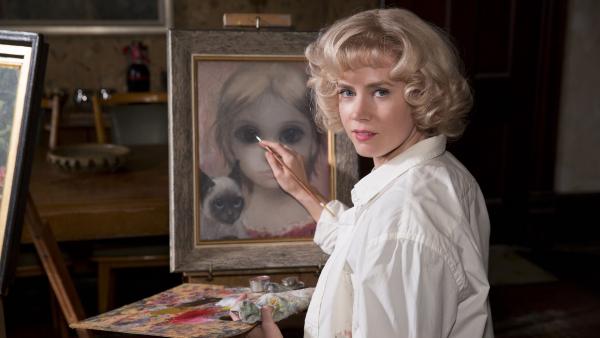'Big Eyes' strips Tim Burton bare

“From far away you look like an artist, but up close you’re nothing”, a line from Tim Burton’s new film, Big Eyes, that could come to describe the trajectory of his career. Throughout the 80’s and 90’s he established a reputation as the kind of auteur situated comfortably between the demands of art and commerce; meaning he could adapt all sorts of brands to the screen, whether they be a comic book (Batman), television show (Pee-Wee’s Big Adventure) or even trading card (Mars Attacks!), all while maintaining a distinctly personal touch arisen from gothic horror, expressionism, animation and mid-20th century kitsch.
Like another animator-turned-live action director, Frank Tashlin, Burton’s work often acknowledges the overwhelming presence of corporate culture and vulgarity (just look at the opening credits of Big Eyes showing the mechanical reproduction of a piece of art). Yet beginning the new millennium with his rather indifferent Planet of the Apes remake, it quickly became evident that Burton’s balance was starting to tip one way, and by his nadir, 2010’s computer generated monstrosity Alice in Wonderland, it seemed that his role as traffic cop of industrial product was firmly in place. Thus came the question of if he was fooling us the entire time?
With his newest film seeing him stripped of an enormous budget or source material with a built-in audience, therein lies some pressure on Big Eyes to deliver “vintage” Burton. Though even though he does his best to design the thing, unfortunately he’s let down by his script, based on the true story of Margaret and Walter Keane (Amy Adams and Christoph Waltz respectively), the artist couple who’s kitschy paintings of wide-eyed, often crying children saw massive commercial success in the early 1960’s. Yet calling it “theirs” is where the drama ensues; the repressed Margaret being the one who does the actual painting, while the assertive, bombastic Walter manages to sell them by passing them off as his own.
Beginning the film in 1958 with Margaret walking out on her first husband, the film’s feminist angle is established, yet a problem comes apparent once we’re quickly reminded of us this by a narrator, and a male one at that, reporter Dick Nolan (Danny Huston), who’s inconsistent presence throughout the film both as onscreen character and off-screen voice points to the half-baked product at hand.
The biopic terrain isn’t strange territory for Burton, being that his likely most critically acclaimed film, Ed Wood saw him portray the worst director of all time with utter sympathy even while stylizing it to the extreme. While Big Eyes doesn’t initially seem as steeped in homage or rather Burton’s comfort zone, he along with his collaborators old (costume designer Colleen Atwood) and new (cinematographer Bruno Delbonnel) favor a kind of realism-shunning period recreation, which through heightened color and architecture, makes sure the world doesn’t feel lived-in, but rather brand new.

Yet the film has trouble in placing the characters who inhabit these gaudy homes and costumes. While positioned as essentially Margaret’s story, Walter’s presence overwhelms the film, being that Burton pushes all the performances into caricature as to be of a piece with his baroque period design. The script feels most adept at revealing the characters’ psychology through their respective fears; Margaret hallucinating the horrific eyes she paints appearing on the faces of strangers (and including at one point her husband’s) while Walter’s of being revealed a phony (Terrence Stamp’s dismissive senior art critic introduced via an anachronistic television appearance). There’s an easy contrast between them; one creates images borne out of real life, the other needs to project an image to survive. Yet covering nearly a decade in less than two hours, Margaret and Walter aren’t developed much beyond that, instead remaining just mannered timidity and award-mongering showboating respectively.
Of course, the seeming structural requirements of the biopic also render the film episodic and tonally schizophrenic, yet the latter isn’t necessarily a problem as at least Burton’s genre chops come to use with late veers into domestic horror as Walter’s paranoia and alcoholism wreak havoc . Yet even with the brief realizations of the film’s the-monster-at-home potential, by the time Big Eyes settles on a tidy courtroom drama, or rather farce, for its climax, there comes the crushing realization that the film has the most ordinary end-game in mind.
Though this question of means and ends in style points to what ultimately what even this “small” film reveals about Burton, and moreso the kind of quality that separates an artist from a mere craftsman; to not just guide the parts along, but reconfigure them too. Thus yes, Burton may ultimately have more in common with the phony than the actual painter.
- Ethan Vestby is the host of Station to Station


